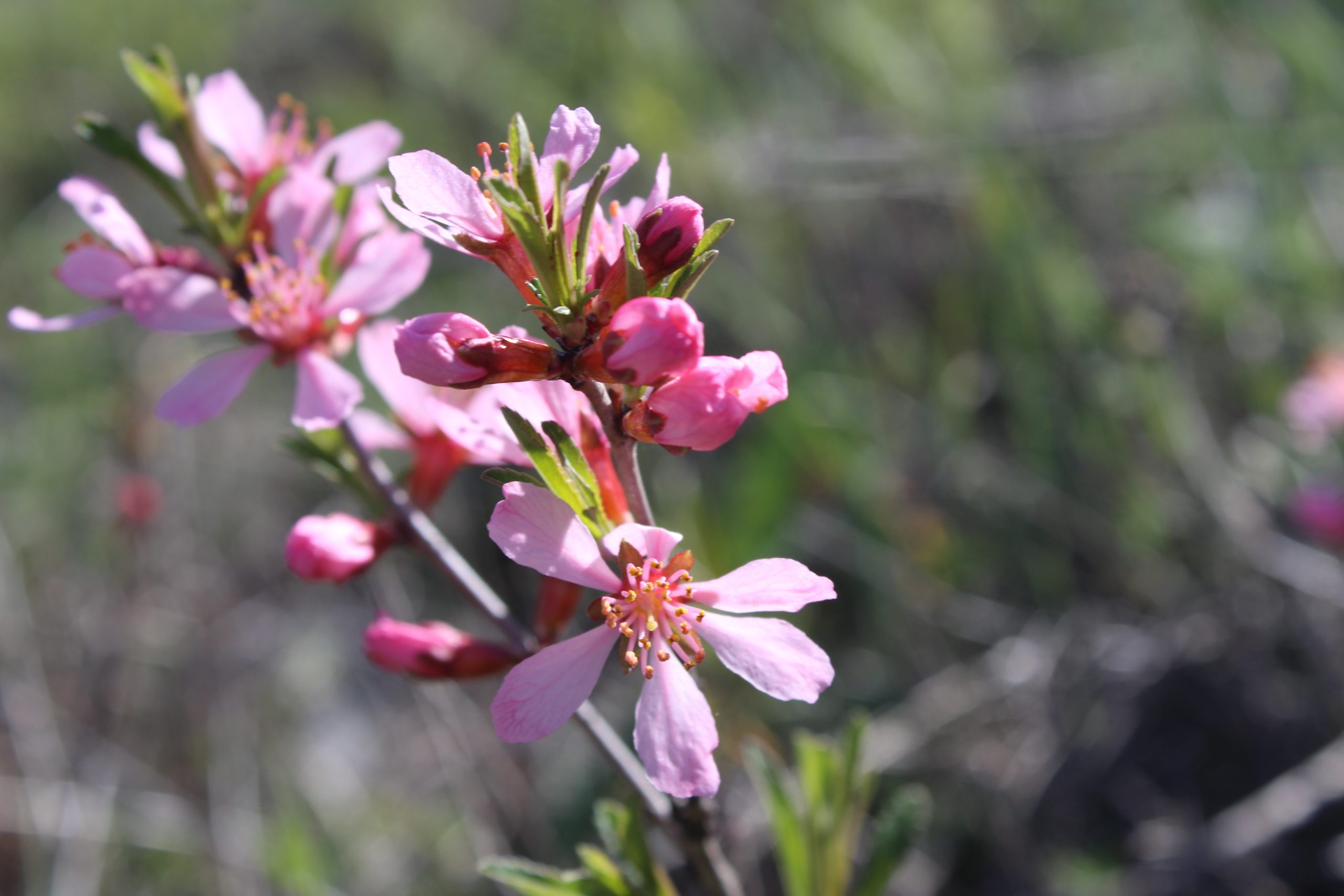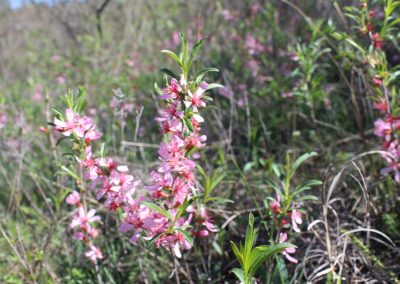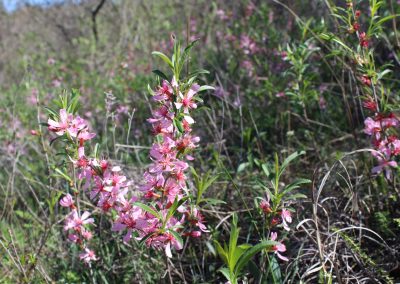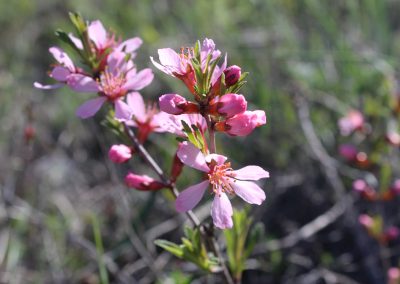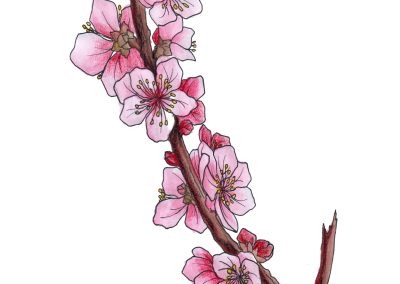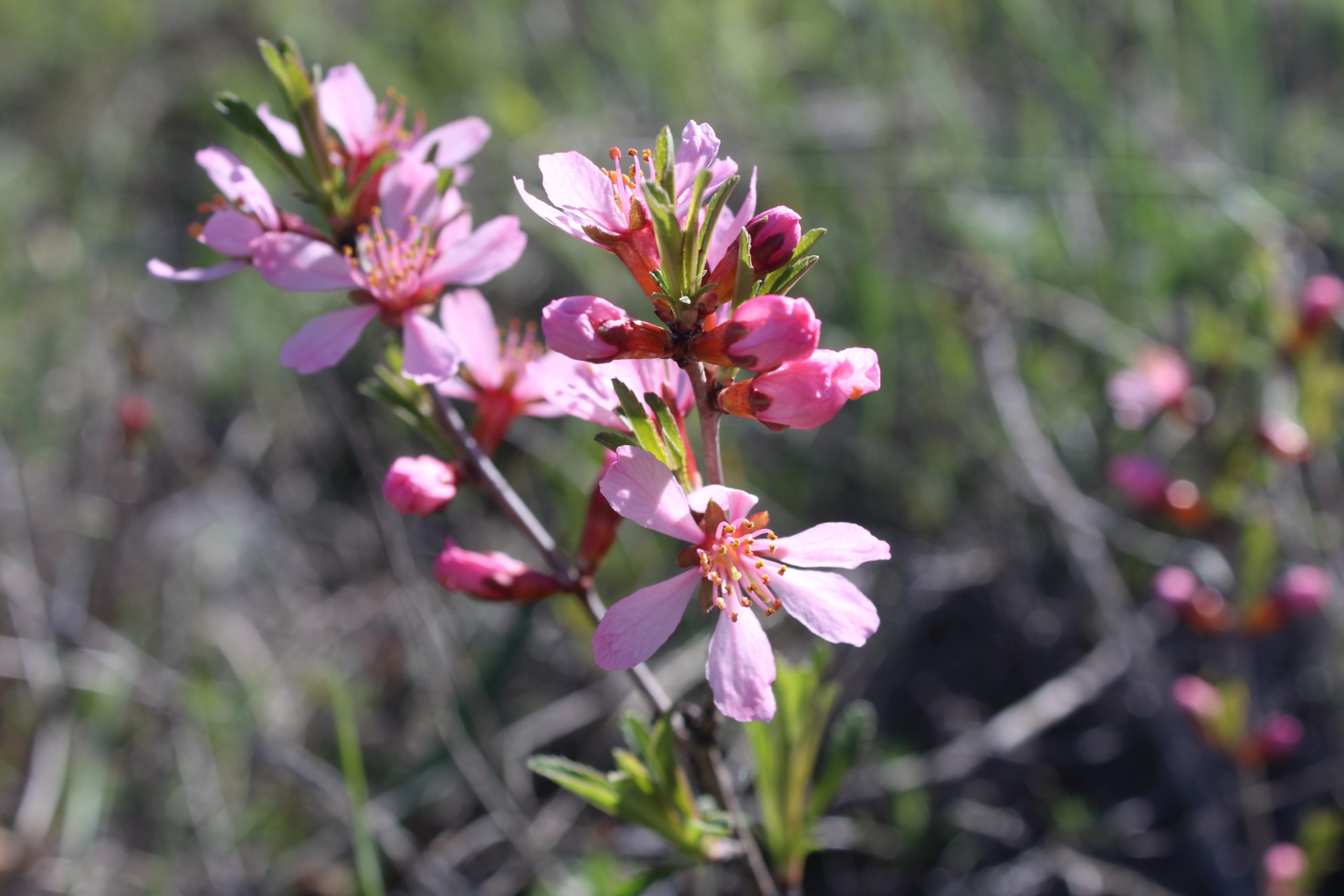Amygdalus Nana
Scientific description
Taxon: Angiospermatophyta (Magnoliophyta)
Class: Dicotyledonatae (Magnoliatae)
Subclass: Rosidae
Order: Rosales
Family: Rosaceae
Subfamily: Prunoideae
Origin: Eurasian
Common name: Dwarf Almond
Description: It is an ornamental shrub with heights of 1–1.5 m. The leaves are lanceolate or obovate-lanceolate, 3–6 cm long, glabrous with short petioles. The flowers, arranged in 1–3, are sessile or shortly petiolate, light pink or white, appearing before the leaves. Pollination is entomophilous. It blooms in late March–April. The fruit is pubescent, ovoid with bitter seeds.
Propagation: By seed as soon as the fruits have reached physiological maturity, by cuttings, suckers, grafting, or division of the clump.
Ecology: In many areas of the country, in warm, dry, steppe areas on hills and sunny coasts. Prefers sunny and semi-shaded places, resistant to drought and frost.
Use: It can be cultivated as an ornamental plant in groups or isolated, decorative. It also has pharmaceutical importance due to the fruits that are rich in vitamins, minerals, tannin, volatile oils. It is recommended in avitaminosis, enterocolitis, peripheral circulation disorders.
Danger: It is affected by silver leaf disease, Chondrostereum purpureum.
Încrengătura: Angiospermatophyta (Magnoliophyta)
Clasa: Dicotyledonatae (Magnoliatae)
Subclasa: Rosidae
Ordinul: Rosales
Familia: Rosaceae
Subfamilia: Prunoideae
Origine: euroasiatică
Denumire populară: migdal pitic
Descrierea: Este un arbust ornamental cu înălțimi de 1–1,5 m. Frunzele sunt lanceolate sau obovat-lanceolate, de 3–6 cm lungime, glabre cu pețiol scurt. Florile sunt câte 1–3, sesile sau scurt pețiolate, de culoare roz-deschis sau albe, apar înaintea frunzelor. Polenizarea este entomofilă. Înflorește la sfârșit de martie–aprilie. Fructul este pubescent, ovoid cu semințe amare.
Înmulțirea: Prin sămânță imediat ce fructele au ajuns la maturitatea fiziologică, prin butași, drajoni, altoire sau despărțirea tufei.
Ecologia: În multe zone din țară, în locuri calde, uscate, stepice pe coline și coaste însorite. Preferă locurile însorite și cu semiumbră, rezistă la secetă și ger.
Utilizare: Poate fi cultivat ca plantă ornamentală în grupuri sau izolat. Are și importanță farmaceutică, datorită fructelor bogate în vitamine, săruri minerale, tanin, uleiuri volatile. Se recomandă în avitaminoze, enterocolite, tulburări de circulație periferică.
Pericol: Este afectat de boala frunzelor de argint, Chondrostereum purpureum.
Γένος: Angiospermatophyta (Magnoliophyta)
Κλάση: Magnoliatae
Υποκατηγορία: Rosidae
Τάξη: Rosales
Οικογένεια: Rosaceae
Υποοικογένεια: Prunoideae
Καταγωγή: Ευρασία
Δημοφιλής ονομασία: αμυγδαλιά νάνος
Περιγραφή: Είναι καλλωπιστικός θάμνος με ύψος 1–1,5 μ. Τα φύλλα είναι λογχοειδή ή ωοειδή-λογχοειδή, μήκους 3–6 εκ., άτριχα με κοντό μίσχο. Τα άνθη είναι 1–3, άμισχα ή βραχύμισχα, απαλό ροζ ή λευκά, εμφανίζονται πριν από τα φύλλα. Η επικονίαση είναι εντομοφιλική. Ανθίζει στα τέλη Μαρτίου–Απριλίου. Ο καρπός είναι εφηβικός, ωοειδής με πικρούς σπόρους.
Πολλαπλασιασμός: Με σπόρο μόλις ο καρπός φθάσει σε φυσιολογική ωριμότητα, με μοσχεύματα, βλαστούς, εμβολιασμό ή με διαίρεση του θάμνου.
Οικολογία: Σε πολλά μέρη της χώρας, σε θερμά, ξηρά, στεπώδη μέρη σε ηλιόλουστους λόφους και ηλιόλουστες ακτές. Προτιμά ηλιόλουστες και ημισκιερές θέσεις, ανθεκτικό στην ξηρασία και τον παγετό.
Χρήση: Μπορεί να καλλιεργηθεί ως καλλωπιστικό φυτό σε ομάδες ή μεμονωμένα. Έχει επίσης φαρμακευτική σημασία λόγω των καρπών του που είναι πλούσιοι σε βιταμίνες, μεταλλικά άλατα, τανίνη, πτητικά έλαια. Συνιστάται σε αβιταμίνωση, εντεροκολίτιδα, διαταραχές της περιφερικής κυκλοφορίας.
Κίνδυνος: Προσβάλλεται από την ασθένεια των ασημόφυλλων, Chondrostereum purpureum.
Taxonomie : Angiospermatophyta (Magnoliophyta)
Classe : Dicotylédones (Magnoliatae)
Sous-classe : Rosidae
Ordre : Rosales
Famille : Rosaceae
Sous-famille : Prunoideae
Origine : Eurasie
Nom commun : Amande naine
Description : C'est un arbuste ornemental d'une hauteur de 1–1,5 m. Les feuilles sont lancéolées ou obovales-lancéolées, de 3–6 cm de long, glabres avec des pétioles courts. Les fleurs, disposées en 1–3, sont sessiles ou brièvement pétiolées, rose clair ou blanches, apparaissant avant les feuilles. La pollinisation est entomophile. La floraison a lieu fin mars–avril. Le fruit est pubescent, ovoïde avec des graines amères.
Propagation : Par semences dès que les fruits ont atteint leur maturité physiologique, par boutures, drageons, greffes ou division de la touffe.
Écologie : Dans de nombreuses régions du pays, dans les zones steppiques chaudes et sèches, sur les collines et les côtes ensoleillées. Préfère les endroits ensoleillés et semi-ombragés, résiste à la sécheresse et au gel.
Utilisation : Elle peut être cultivée comme plante ornementale en groupes ou isolée. Elle a également une importance pharmaceutique grâce à ses fruits riches en vitamines, minéraux, tanin, huiles volatiles. Recommandée contre l’avitaminose, l’entérocolite et les troubles de la circulation périphérique.
Danger : Elle est affectée par la maladie de la feuille d'argent, Chondrostereum purpureum.
Creative writing inspired by Amygdalus Nana
A Bloom Against the Frost
In the past, the lands where Amygdalus Nana grew were often harsh, with vast expanses of dry, rocky soil. Despite these awful conditions, the dwarf almond thrived, its delicate pink blossoms providing a stark contrast to the barren landscape. This resilience led to the plant becoming a symbol of endurance and hope for the local people.
Alina, a beautiful maiden, lived in a small village at the edge of the steppe. Alina was known to be very kind and gentle, always ready to help those who needed to be helped.
During a particularly hard winter, a severe drought followed by a brutal frost left the village on the edge of starvation. The villagers prayed to the gods for salvation, but they received nothing but silence. As the situation got worst, Alina ventured into the steppe, hoping to find some food or water to save her people.
After days of wandering, Alina stumbled upon an Amygdalus Nana shrub. Despite its frail appearance, she noticed tiny pink buds beginning to bloom. Taking this as a sign of hope, she carefully dug around the plant, uncovering a hidden spring that had nourished its roots. Alina quickly filled her containers with water and brought them back to the village.
The water from the spring sustained the villagers, and Alina returned to the steppe to tend to the Amygdalus Nana. She nurtured the shrub, ensuring it thrived and bloomed even more beautifully. Her dedication to the plant was seen as an act of divine intervention, and the villagers believed that the gods had sent Alina to save them through the miraculous discovery of the spring and the resilient Amygdalus Nana.
From that time on, Amygdalus Nana was revered as a sacred plant, symbolizing hope and endurance. Alina's story was passed down through generations, reminding people of the power of faith, resilience, and the importance of caring for nature.


